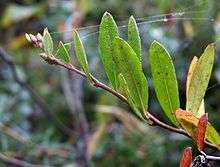Chamaedaphne
Chamaedaphne calyculata, known commonly as leatherleaf or cassandra, is a perennial dwarf shrub in the plant family Ericaceae and the only species in the genus Chamaedaphne. It is commonly seen in cold, acidic bogs and forms large, spreading colonies.
| Chamaedaphne | |
|---|---|
 | |
| Scientific classification | |
| Kingdom: | Plantae |
| Clade: | Tracheophytes |
| Clade: | Angiosperms |
| Clade: | Eudicots |
| Clade: | Asterids |
| Order: | Ericales |
| Family: | Ericaceae |
| Subfamily: | Vaccinioideae |
| Tribe: | Gaultherieae |
| Genus: | Chamaedaphne Moench |
| Species: | C. calyculata |
| Binomial name | |
| Chamaedaphne calyculata (L.) Moench | |
| Synonyms | |
|
Andromeda calyculata L.[1] | |
Description
Chamaedaphne calyculata is a low-growing, upright dwarf shrub up to 1.5 m tall. The leaves are alternately arranged on the branch and elliptical to oblong shaped, 1–4 cm long and 0.5-1.5 cm wide. The leaves are thick and leathery, dull green above with minute, silvery scales, and paler green or brownish beneath. The margins of the leaves are entire or slightly and irregularly toothed, with short petioles. The plant is evergreen but leaves often turn red-brown in winter.[2] The lower stems extend into sphagnum, peat moss, or other substrate, and may persist even after fire or mild drought.[3]
The plant flowers in April to June, and is insect-pollinated. Flowers are small (5–6 mm long), white, and bell-like, produced in terminal racemes up to 12 cm long, with flowers emerging from the axils (between leaf and stem) of small leaves on the raceme. The flowers have fused petals with 5 short lobes. The fruit is a capsule,[4] a dry fruit that splits open to release seeds.
Etymology
The name Chamaedaphne is said to be derived from the Greek word chamae for "on the ground," and daphne, meaning "laurel." In ancient Greek chamai (χαμαί) expresses "on the ground".[5] The common name refers to its tough, leather-like leaf.
Habitat
Chamaedaphne calyculata has a circumboreal distribution throughout the cool temperate and subarctic regions of the Northern Hemisphere from eastern North America to bogs in Finland and Japan. The species site is mostly restricted to bogs, but also occur in shrubby fens, rock crevices, and pool margins. Leatherleaf naturally forms large clonal colonies, but is very shade-intolerant. Nutrients are low in bogs due to low mineralization, and plants can only acquire nutrients only from atmospheric sources.[6]
Uses
Leatherleaf is used as a food plant by the larvae of some Lepidoptera species including Coleophora ledi. In ornamental usage, leatherleaf is widely used by florists as a filler green in bouquets and arrangements. Ethnobotanically, the plant has usage as "sun-tea," a drink in which dried or fresh leaves are steeped in cool water in a sunny location. This technique is used to avoid boiling it as a traditional infusion, which carries the danger of releasing andromedotoxin, a common toxin present in plants of the family Ericaceae. Leatherleaf also has limited medicinal use among some Native American tribes as a poultice of leaves for inflammation.[7]
References
- "Andromeda calyculata". Germplasm Resources Information Network (GRIN). Agricultural Research Service (ARS), United States Department of Agriculture (USDA). Retrieved 21 December 2017.
- Barnes, Burton Verne, et al. Michigan Shrubs & Vines: a Guide to Species of the Great Lakes Region. University of Michigan Press, 2016.
- Reznicek, A.A., E. G. Voss, & B. S. Walters. MICHIGAN FLORA ONLINE. February 2011. University of Michigan. Web. April 9, 2018. http://michiganflora.net/species.aspx?id=1210.
- Haines, Arthur, and Gordon Morrison. Flora Novae Angliae: a Manual for the Identification of Native and Naturalized Vascular Plants of New England. New England Wild Flower Society, 2011.
- Liddell, H.G. & Scott, R. (1940). A Greek-English Lexicon. Revised and augmented throughout by Sir Henry Stuart Jones with the assistance of Roderick McKenzie.Oxford: Clarendon Press.
- Bartsch, Ingrid. "Effects of fertilization on growth and nutrient use by Chamaedaphne calyculata in a raised bog." Canadian Journal of Botany 72.3 (1994): 323-329.
- http://wildadirondacks.org/adirondack-shrubs-leatherleaf-chamaedaphne-calyculata.html Adirondack Shrubs: Leatherleaf
External links
| Wikimedia Commons has media related to Chamaedaphne calyculata. |
| Wikispecies has information related to Chamaedaphne |
